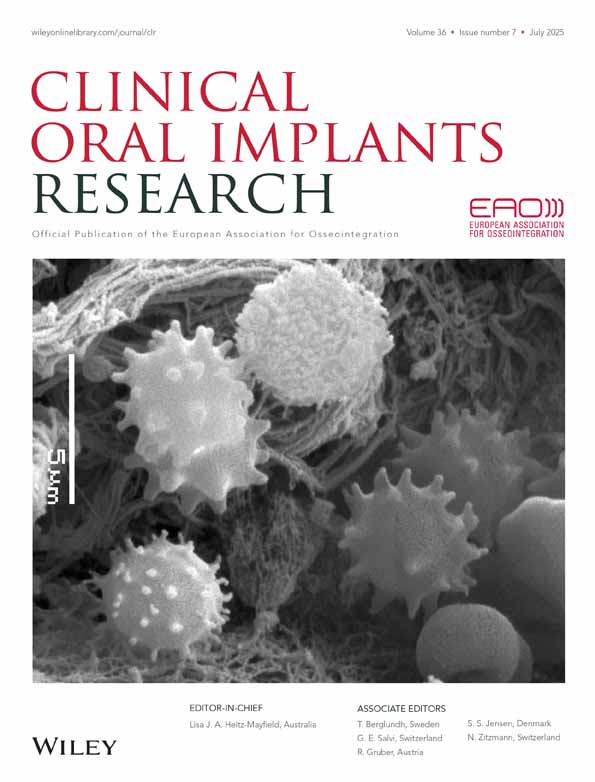Histomorphological evaluation of loaded plate-form and root-form implants in Macaca mulatta monkeys
Abstract
enAbstract: As part of a long-term evaluation of endosteal dental implants in primates, this paper describes the histological response to plate-form and root-form implants. Thirty-six primates received 48 mandibular distal abutment implants. After healing, the implants were restored with fixed partial dentures, which remained in function for two years. A subset of the group was ligated at the gingival sulcus to biologically stress tissues supporting the implants. Crestal bone height around implants was quantified using digital subtraction radiographic techniques. The ligated implants lost more crestal bone than non-ligated implants, as shown by ANOVA (P < 0.05). After retrieval, implants were embedded and sectioned for histomorphometric analysis including measurement of per cent osseointegration. Both plate-form and root-form non-ligated implants demonstrated about 60% osseointegration. When ligated, plate-form implants dropped to an average integration of only 34%, while root-form implants maintained 62% integration, a significant difference. These data show that in this primate model, plate-form and root-form implants maintained integration while in function for two years. When stressed with ligation, root-form implants maintained relative amounts of osseointegration, while per cent osseointegration of plate-form implants decreased.
Résumé
frCe manuscript décrit la réponse histologique à long terme au niveau des implants-plateau ou racine. Trente-six primates ont reçu 48 implants comme pilier distal au niveau de la mandibule. Après guérison, les implants ont été chargés avec des prothèses partielles fixées qui sont restées en fonction durant deux années. Un sous-groupe a été ligaturé au niveau des sulci gingivaux afin d'augmenter l'accumulation de plaque dentaire au niveau de ces implants. La hauteur osseuse crestale autour des implants a été quantifée en utilisant des techniques de soustraction radiologique. Les implants ligaturés ont perdu davantage d'os crestal que les non-ligaturés (ANOVA: P<0.05). Après leur avulsion les implants ont été enfouis dans des blocs et découpés pour une analyse histomorphométrique évaluant la mesure de l'ostéointégration. Les deux types d'implant avaient une ostéintégration d'environ 60%. Lorsqu'il y avait une ligature, les implants-plateau avaient une diminution de l'intégration allant jusqu'à 34% tandis que ceux en forme racine maintenaient une intégration de 62%. Ces données ont montré que dans ce modèle de primate, les implants-plateau et -racine maintenaient une intégration durant leur mise en fonction de deux années. Lorsqu'une ligature était placée les implants-racine maintenaient une bonne quantité d'ostéo?ntégration tandis que cette dernière était significativement inférieure lorsque les implants-plateau étaient utilisés.
Zusammenfassung
deDiese Arbeit ist Teil einer Langzeitstudie über enossale Zahnimplantaten an Primaten und beschreibt die histologische Antwort auf scheiben- und wurzelförmige ?mplantate. 36 Primaten erhielten 48 seitliche Unterkieferimplantate. Nach der Heilphase wurden die ?mplantate mit festsitzenden Teilprothesen versorgt, die während zwei Jahren in Funktion verblieben. Ein Teil der Gruppe erhielt im den Sulcus eine Ligatur, um die dem ?mplantat angrenzendenden Gewebe einer biologischen Stressituation auszusetzen. Die Höhe des Alveolarknochens um die ?mplantate wurde mit Hilfe der digitalen Subtraktionsradiographie quantitativ erfasst. Die ?mplantate mit einer Ligatur verloren mehr Alveolarknochen als die nichtligierten ?mplantate (ANOVA; P<0.05). Nach der Entnahme wurden die ?mplantate eingebettet und histologische Schnitte angefertigt. Diese dienten der histomorphometrischen Analyse und der Bestimmung des Osseointegrationsgrades in Prozenten. Sowohl die scheiben-, wie auch die wurzelförmigen ?mplantate zeigten ohne Ligaturen eine 60%-ige Osseointegration. Wurden aber Ligaturen angelegt, so reduzierte sich der Grad der Osseointegration bei den scheibenförmigen ?mplantaten auf 34%, bei den wurzelförmigen ?mplantate auf 62%, es handelte sich um einen signifikanten Unterschied. Die Resultate dieses Primatenmodells zeigen, dass die scheiben- und wurzelförmigen ?mplantate während einer Funktionszeit von zwei Jahren ihre Osseointegration beibehalten. Werden die Gewebe aber mit Ligaturen zur experimentellen Entzündung gebracht, können die wurzelförmigen ?mplantate ihren Osseontegrationsgrad beibehalten, bei den scheibenförmigen ?mplantaten nahm er ab.
Resumen
esComo parte de una evaluación a largo plazo de implantes dentales endoóseos en primates, este trabajo describe la respuesta histológica a implantes con forma de placa y con forma de raíz. Treinta y seis primates recibieron 48 implantes distales mandibulares con pilar. Tras la cicatrización, los implates se restauraron con dentaduras parciales fijas, que permanecieron en functión durante 2 años. A un subconjunto del grupo se les colocó una ligadura en el surco gingival para estresar los tejidos que soportan los implantes. Se cuantificó la altura de la cresta ósea alrededor de los implantes usando técnicas radiográficas de sustracción digital. Los implantes ligados perdieron mas hueso crestal que los implantes no ligados, como se muestra en ANOVA (P<0.05). Tras la retirada, los implantes se embebieron y seccionaron para análisis histomorfométrico incluyendo mediciones del porcentaje de osteointegración. Tanto los implantes con forma de placa como los de forma de raíz no ligados mostraron un 60 por ciento de osteointegración. Cuando se ligaron, los implantes con forma de placa bajaron a una media de integración de solo el 34 por ciento, mientras que los implantes con forma de raíz mantuvieron el 62 por ciento de integración, una diferencia significativa. Estos datos muestran que en este modelo de primates, lo implantes con forma de placa y forma de raíz mantuvieron la integración en función durante 2 años. Al estresarse con ligaduras, los implantes con forma de raíz mantuvieron unas cantidades relativas de osteointegración, mientras que el porcentaje de integración de los implantes con forma de placa disminuyó.




